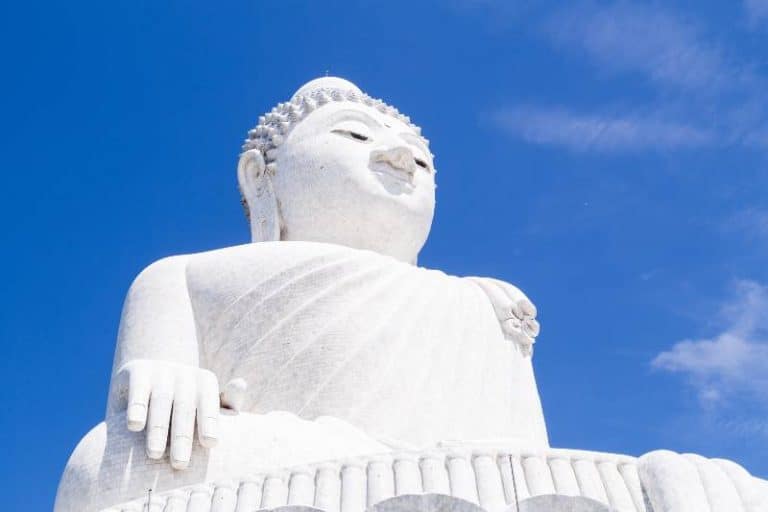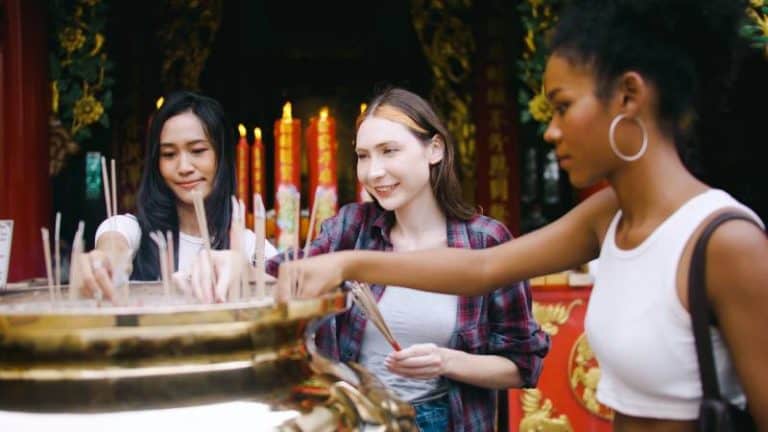Thai Etiquette 101: Customs You Need to Know
If you’re planning a trip to Thailand, you should know that there are many customs and etiquette distinct to the country. To ensure your travels go as smoothly as possible, it’s important to understand and observe proper Thai behavior—from respecting local traditions like not touching someone on their head or pointing feet towards an altar or statue of Buddha, to making sure to greet people politely or wait until everyone has been served food before starting a meal. This blog post will provide you with all the key information about Thai culture and its nuances so check out these customs and etiquette guidelines below!
In Thailand, it is important to follow a strong hierarchical system when it comes to culture and etiquette. This means showing respect to those who hold a higher social status and to older individuals.
Key Takeaways
- In Thai culture, showing respect and preserving one’s reputation are highly valued. It’s crucial to keep this in mind and refrain from actions that may cause others to feel ashamed or embarrassed.
- Understanding Thai customs and etiquette can greatly enhance your experience in Thailand, whether you’re visiting a temple, dining out, or visiting someone’s home. Taking the time to learn about local customs and behaving respectfully can help you build stronger relationships and create positive memories.
- When in doubt, observe what locals are doing and follow their lead. Thais are generally forgiving of cultural missteps by foreigners, but showing an effort to understand and respect Thai customs can go a long way in building goodwill and appreciation.

Respect for the Monarchy
Thailand is a constitutional monarchy, and Thais hold their royal family, particularly the King, in the highest esteem. The King is seen not just as a head of state, but as a symbol of national identity and unity. The respect for the monarchy is deep-rooted and transcends all aspects of Thai life.
Historically, Thai Kings were believed to be semi-divine, and this belief, although not prevalent in modern times, influences the way Thais view and treat their monarch. This reverence is reflected in daily life through numerous portraits of the King displayed in public spaces, businesses, and homes. The national anthem, played in public areas like train stations and before movies in theaters, is another moment when Thais show respect to the monarchy by standing in silence.
The Thai legal system also enforces this reverence through the lèse-majesté law, which makes it a criminal offense to defame, insult, or threaten the King, Queen, heir-apparent, or regent. This law, which is Section 112 of the Thai Penal Code, carries a punishment of three to fifteen years imprisonment per count.
As a visitor or ex-pat, it’s crucial to pay respect to these customs. Criticizing the monarchy, including making casual or humorous comments, could lead to serious legal consequences. Even actions that may seem harmless, such as stepping on a Thai coin (which bears the image of the King), can be seen as disrespectful. It’s also important to stand for the Thai national anthem and to show respect when a royal motorcade passes.
In essence, the Thai monarchy is central to the nation’s identity and social fabric, and respecting it is a fundamental part of observing Thai customs and etiquette.
Wai – The Thai Greeting
The ‘Wai‘ is a traditional Thai greeting that consists of a slight bow, with palms pressed together in a prayer-like fashion. The gesture is both a sign of respect and a way to say hello, goodbye, thank you, or acknowledge an apology. The Wai is an integral part of Thailand’s etiquette, reflecting the country’s values of respect, humility, and spiritualism.
The specifics of the Wai – the height of the hands and the depth of the bow – vary based on the social status or age of the Thai person you are greeting. Here are the different types of Wai based on the social hierarchy:
- Wai for monks and Buddha images (Phra Wai): The highest form of the Wai is performed for monks and Buddha images. The hands are raised to the forehead and the person bows deeply, sometimes to the point of kneeling.
- Wai for the King and the Royal family (Thammasat Wai): When greeting the King or a member of the Thai royal family, the hands are held at forehead level and a full bow is made.
- Wai for a person of higher status or older age (Sawatdee Wai): When greeting someone of higher status or someone who is older, the hands are pressed together at chest level and raised towards the face while bowing slightly. The higher the hands, the more respect is shown.
- Wai for equals or younger people (Nop Wai): When greeting peers or people younger than you, a simple bow with hands at chest level is sufficient.
As a foreigner in Thailand, you are not expected to initiate the Wai, but returning it shows respect and understanding of Thai culture. However, it is important for foreign visitors to remember not to Wai service staff, children, or people younger than them, as it’s seen as inappropriate due to the social status difference. Understanding and appropriately using the Wai gesture contributes to an authentic and respectful experience in Thailand.
Thai Temple Etiquette
Visiting a Buddhist temple or ‘Wat‘ is often a highlight of a trip to Thailand. To ensure your visit is respectful to the Thai people and their religious customs, it’s important to observe a certain cultural etiquette, particularly in regard to dress code, interactions with Buddha images and statues, and donations and offerings.
Appropriate Dress Code
When visiting Thai temples, it’s crucial to dress modestly. Both men and women should cover their shoulders and knees. This usually means wearing long pants or skirts and shirts with sleeves. Shoes must be removed before entering the main chapel where the principal Buddha image resides. It’s also respectful to remove hats and avoid bright, flashy clothing.
Respecting Buddha Images and Statues
Buddha images and statues are sacred in Thai culture. Never touch, climb, or pose disrespectfully with them. It’s also considered rude and highly disrespectful to point your feet toward a Buddha image, as feet are considered the lowest part of the body. When sitting in front of a Buddha image, tuck your legs under you to avoid pointing your feet toward the statue.
Donations and Offerings
Donations and offerings are a common practice when visiting Thai temples. You may notice locals offering flowers, incense, and candles, which can usually be purchased at the temple. The donations made often contribute to the maintenance of the temple.
When making an offering, approach the altar and kneel with your feet tucked behind you. Place your offering on the altar, and then perform a Wai, or a series of three bows, to pay your respects.
Remember, each temple may have its own specific rules and customs. When in doubt, observe what locals are doing or ask for guidance. As long as you approach the experience with respect and mindfulness, your temple visit can be a meaningful part of your Thai journey.
Dining Etiquette
Eating is a communal affair in Thailand, often involving several shared dishes. Understanding Thai dining etiquette can enhance the dining experience and show respect for local customs.
Use of Spoon and Fork
In Thai cuisine, the spoon is the main utensil, and a fork is used to help guide food onto the spoon. Unlike Western dining, knives are generally not used, as Thai food is typically prepared in bite-sized pieces. The spoon, held in the right hand (it depends if you are left-handed or right-handed), is used to eat, while the fork, held in the left hand, is used to push food onto the spoon. Sticking your fork directly into your mouth is considered crude, so try to avoid it. Chopsticks are only used when eating noodle dishes.
Communal Dining Norms
Thai meals are often served family-style, with several dishes placed in the center of the table for everyone to share. It’s polite to wait until the oldest or most senior person starts eating or invites others to start. You should take a small portion from the shared dish and put it on your own plate, rather than eating directly from the shared dishes. It’s considered good manners to take a bit of everything and finish all the food on your plate.
Tipping Customs
Tipping is not traditionally a part of Thai culture, but it has become more commonplace, particularly in tourist areas and higher-end establishments. In local restaurants, Thais generally don’t tip, but they might leave behind any loose change. In more upscale restaurants, a tip of 10% to 15% is appreciated if a service charge hasn’t already been added to the bill. For street vendors, food stalls, and casual eateries, tipping is not expected.
Remember, Thai people value a relaxed and enjoyable meal, so don’t rush. Take the time to savor the flavors and the company. Enjoying a meal the Thai way can be one of the most rewarding experiences of your visit.
Social Etiquette
Understanding social and business etiquette here in Thailand is crucial for navigating interactions with locals respectfully and effectively. Key concepts include maintaining face, adopting a non-confrontational approach, and showing respect to elders.
Importance of Maintaining Face
In Thai culture, it is important to maintain face, which means avoiding situations that cause public embarrassment and ensuring that everyone’s dignity, including that of younger person, their family, community, and country is preserved. Criticizing, disagreeing, or reprimanding someone in public may cause them to lose face, which can result in shame and harm relationships. Therefore, communication should always be done in a respectful manner that preserves everyone’s dignity.
Non-Confrontational Approach
In Thailand, people tend to avoid direct disagreement or conflict during social interactions. They prioritize maintaining a positive atmosphere and avoiding any disruption in harmony, sometimes resorting to indirect communication, agreeing to avoid negative responses, or using humor to diffuse tough situations. As a visitor, it is advisable to also adopt a similar approach and handle any issues with patience and a friendly attitude.
Showing Respect to Elders
In Thai society, it is highly valued to show respect to elders. This value is instilled in individuals from a young age and is expressed in different manners, such as greeting elders first with the Wai gesture, attentively listening when they speaking Thai language, and displaying courteous behavior towards them. It is crucial to exhibit respect towards older individuals in social and work-related situations.
Remember, while Thai people are generally forgiving of cultural missteps by foreigners, showing an understanding and respect for Thai etiquette can greatly enhance your interactions and experiences in Thailand.
Visiting a Thai Home
Removing shoes
In Thai homes, it’s customary to remove shoes before entering. You should see a collection of shoes outside the house, which is a good indication that you should remove your shoes as well. It’s polite to wear socks or bring a pair of clean slippers to wear indoors.
Gift-giving norms
In Thailand, gift giving is typically casual and not obligatory, except for significant or very formal occasions like weddings. Nonetheless, presenting a nicely packaged, uncomplicated gift can be a meaningful way to express gratitude and strengthen friendships. If you plan on gifting something to a Thai friend or host, here are some essential points to keep in mind.
- Avoid using black, blue, or green to wrap a gift since they represent mourning and are commonly used during funerals. Instead, if you plan to give appropriate gifts to Chinese Thais, choose red because it’s an auspicious color for them. It is not common for Thais to open a gift in front of the giver.
- When choosing a gift for your host, you can consider options like fruit, flowers, candy, or chocolates. You could also opt for books, liquor, or stationary. It’s important to use your best judgment and think about what your host would appreciate or find useful.
- Bringing a gift to someone’s home is not necessary, but it is always a thoughtful gesture to show gratitude with a small token.
Thai Festivals and Celebrations
Songkran (Water Festival)
The Songkran festival begins on April 13 in Thailand and typically lasts for three days, although the celebration’s start and end may vary in different cities. The festival’s primary theme is progression, as the word “Songkran” is derived from a Sanskrit phrase that refers to the sun’s transition.
The festival involves water as a key element, which represents a symbolic purification of the past year in preparation for the upcoming one. Additionally, there are various other Songkran customs that also incorporate the use of water.
Loi Krathong (Lantern Festival)
The Loy Krathong Festival is a yearly event in Thailand where people pay homage to the Goddess of Water and the Buddha. Although it is not a national holiday, it is celebrated all across the country. During the festival, individuals gather near bodies of water such as lakes, rivers, and canals to release floating lanterns or Krathongs onto the water.
Discover the fascinating cultures and rich traditions of Thailand! From exquisite Thai cuisine and warm hospitality to stunning temples and vibrant festivals, there’s so much to explore and admire. Let’s dive deeper into the wonders of Thailand and its people, make sure to read it here. Don’t miss out on the chance to immerse yourself in this captivating culture!

Thai Customs and Etiquette You Should Know FAQs
How do Thais usually eat their meals?
In Thailand, people usually eat with a spoon and a fork, but they may use only their right hand sometimes because they consider the left hand unclean. When eating soup, pour it into your bowl and use your spoon to eat it politely.
What does ‘maintaining face’ mean in Thai culture?
In Thai culture, expressing strong negative emotions here can be seen as a sign of weakness and may lead to social rejection. This makes it difficult for people to openly share their negative feelings, resulting in many Thais hiding their emotions in order to “save face.”
What should I do when visiting a Thai home?
Remember to not sit in the worship space of the house without permission. In some Thai families, there may be certain areas, such as the kitchen table and chairs, that should not be sat on without instruction from the landlord. Thank you for waiting for guidance before doing so.
What are the major festivals in Thailand and how are they celebrated?
Some of Thailand’s most enchanting events and festivals are Songkran, where people throw water, Loy Krathong, where people float offerings, and the Naga Fireballs, which appear during the full moon in October from the Mekong River and have an unexplained origin.
How is tipping handled in Thailand?
In Thailand, tipping is not expected or mandatory. However, if you receive excellent service, small gratuities are appreciated. It’s important to note that unlike in some other countries, service providers in Thailand will not ask for tips.
Conclusion
After researching and discovering more about Thai customs and etiquette, you may find that the people of Thailand appreciate respect in all its forms. As a visitor to Thailand, it is especially important to remember to be respectful and mindful of their culture as you travel and explore this wonderful country. Even small things such as greeting someone politely or avoiding doing certain actions can help develop positive relationships with the locals. Hopefully, this blog post has provided some insight into the customs and etiquette in Thailand so that you can make the most out of your experience in this vibrant country.
If you are still on the fence about visiting, just log onto our website where we discuss even more details about living in Thailand – from what to bring when visiting a temple to the regional customs. Be sure you subscribe to our newsletter for the best information about living in Thailand too! We guarantee that by following these simple guidelines, you will have a better and more meaningful journey during your visit.






